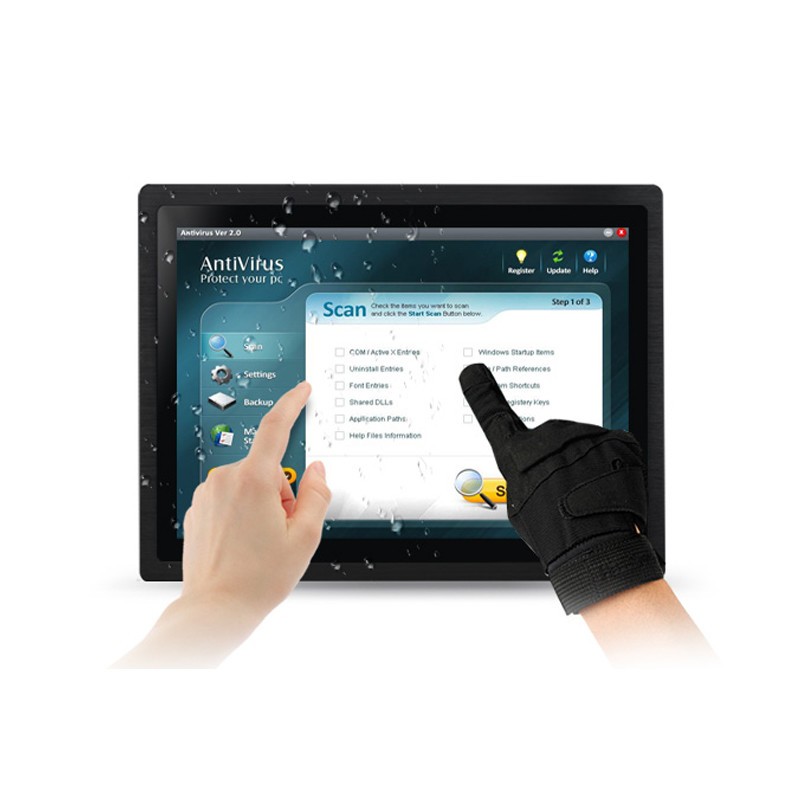How does a waterproof touch screen monitor work?
Waterproof touch screen monitors have become increasingly popular in various industries and applications where exposure to liquids or moisture is a concern. These monitors offer the convenience of touch interaction while providing robust protection against water ingress. In this article, we will delve into the functionality of waterproof touch screen monitors, exploring how they work to provide both touch sensitivity and water resistance.
Touch Screen Technology:
Waterproof touch screen monitors employ various touch screen technologies, including resistive, capacitive, and infrared. These technologies enable the monitor to detect touch inputs and translate them into commands or actions.
Resistive Touch Screens:
Resistive touch screens consist of multiple layers, including a flexible top layer and a rigid bottom layer separated by a small gap. When pressure is applied to the screen, the layers make contact, causing a change in electrical current that determines the touch position. In waterproof resistive touch screens, the top layer is often constructed with a durable and water-resistant material to prevent water damage.
Capacitive Touch Screens:
Capacitive touch screens utilize the conductive properties of the human body or a capacitive stylus to detect touch inputs. These screens are made of a glass or transparent material coated with a conductive layer. When a user touches the screen, the electrical properties of the conductive layer change, allowing the monitor to detect the touch position accurately. Waterproof capacitive touch screens are designed with water-resistant coatings and sealing techniques to protect the internal components.
Infrared Touch Screens:
Infrared touch screens consist of an array of infrared sensors placed around the edges of the screen. These sensors emit infrared light beams across the screen surface. When a user touches the screen, it interrupts the infrared light beams, allowing the monitor to determine the touch position. Waterproof infrared touch screens are sealed to prevent water from entering the enclosure and affecting the sensors.
Water Resistance:
The water resistance of a waterproof touch screen monitor is achieved through several design features. The monitor's enclosure or frame is typically constructed with materials that provide a high degree of sealing, such as gaskets, O-rings, or adhesive seals. This prevents water from seeping into the internal components and damaging them.
IP Rating:
Waterproof touch screen monitors are assigned an IP (Ingress Protection) rating that indicates their level of resistance to water and solid particles. The IP rating consists of two digits: the first digit represents the level of solid particle protection, while the second digit denotes the level of water resistance. For example, an IP65 rating signifies complete protection against dust ingress and protection against water jets from any direction.
Sealing Techniques:
Manufacturers employ various sealing techniques to ensure the water resistance of touch screen monitors. These may include using specialized seals around connectors and cables, employing waterproof adhesives for bonding components, and implementing design features that prevent water from reaching sensitive areas.
Compatibility with Gloves:
Certain waterproof touch screen monitors are designed to be compatible with gloved operation. This is achieved by incorporating capacitive touch technology that can detect touch inputs even through gloves, allowing users to interact with the monitor without the need to remove their gloves.
Conclusion:
Waterproof touch screen monitors combine the functionality of touch screen technology with robust water resistance, making them suitable for environments where exposure to liquids or moisture is a concern. By utilizing resistive, capacitive, or infrared touch screen technologies and implementing effective sealing techniques, these monitors offer reliable touch sensitivity while safeguarding internal components from water damage. When selecting a waterproof touch screen monitor, it is essential to consider its touch screen technology, water resistance features, and the appropriate IP rating to ensure its suitability for the intended environment and application.


